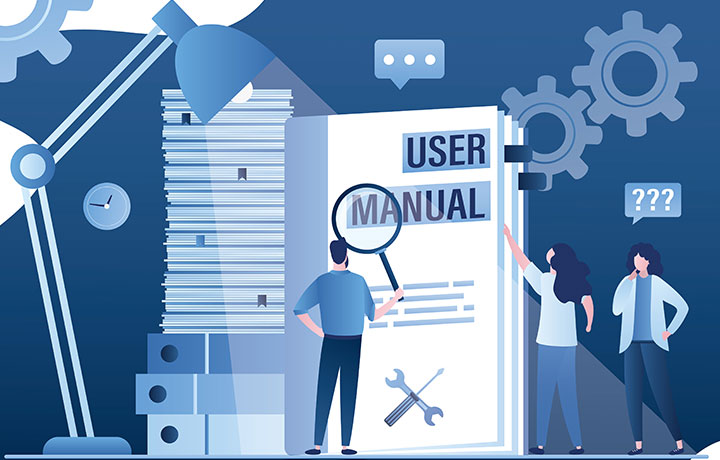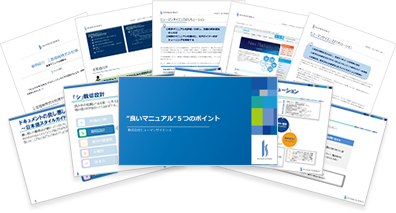
Hello! I am Consultant S.
I usually handle manual creation and improvement projects for companies in the manufacturing and human resources industries.
This time, I will write a blog about "the personalization of operations." Many companies in the manufacturing and human resources sectors face various challenges due to the personalization of operations, such as work stagnation due to the retirement or sudden absence of veteran employees, excessive time spent on training new employees, and the concentration of workload on specific employees.
I usually handle manual creation and improvement projects for these companies, supporting the elimination of task dependency.
While delving into "the personalization of business operations," in the latter half, we will introduce specific examples of how our company has worked to eliminate the personalization of business operations.
- Table of Contents
-
- 1. What are the causes of business becoming dependent on individuals?
- 1-1. What is the personalization of business?
- 1-2. Causes of Job Personalization
- 2. Risk of Business Personalization
- 3. Methods to Eliminate Dependency on Specific Individuals in Business
- 4. Case Studies on Eliminating Task Dependency through Manual Creation
① Docomo Technology Inc.
② Tokyu Livable Inc. - 5. Summary
- 6. For inquiries about manual creation, contact Human Science
1. What are the causes of business becoming dependent on individuals?

1-1. What is the personalization of business?
First, let's take a look at what is meant by the personalization of business operations.
The personalization of work refers to a situation where only specific individuals are aware of certain tasks. In this state, the details of how to carry out the work are only known to the person who usually performs it, which can lead to a halt in operations if that person is unavailable. Tasks that are personalized can be difficult for others to take over if proper handovers are not conducted, ultimately becoming a factor that lowers the overall productivity of the company.
So, what causes the personalization of work?
1-2. Causes of Job Personalization
The causes of personalization are mainly as follows.
• Highly specialized
When the business content is very specialized and difficult to share with others, it becomes personalized to specific individuals. This is especially true for tasks that require technical skills, as the number of people with those skills is limited, making personalization more likely.
• Overwhelmed with work
One reason is that time is consumed by core business activities, leaving little room for education and information sharing. With daily tasks taking precedence, teaching successors and colleagues about the work often gets postponed.
• Efforts for information sharing are often undervalued
One of the reasons for the lack of progress in eliminating dependency on individuals is that efforts such as establishing methods and rules for information sharing and preparing content for training new employees are not sufficiently valued within the company. When these efforts are not recognized, their priority decreases, and the situation of dependency on individuals is left unaddressed.
• There are employees who want to maintain their position within the company
Some employees may think that sharing their work with others could diminish their value. As a result, they may intentionally make their work more specialized to strengthen their position.
The personalization of operations often occurs due to a combination of several factors.
For example, in a certain manufacturing site, the following factors were intertwined, leading to the personalization of operations.
• Due to the impatience of wanting to achieve results quickly, the immediate tasks are prioritized over creating procedural documents.
• As a result, personalized work procedures become established, making it difficult to hand over tasks to other members.
• The difficulty of handover further increases dependence on specific employees.
• The employee who is overwhelmed with work becomes unable to allocate time for training and information sharing.
In this way, the personalization of business operations is often caused by multiple factors.
So, what risks are there when business operations have become personalized?
2. Risk of Task Dependency

Next, let's take a closer look at the main issues caused by personalization.
• Uneven distribution of workload
Personalized tasks place a significant burden on the employees responsible for them. As a result, this can lead to increased overtime and stress, negatively impacting the health and performance of those employees.
• It becomes difficult to improve business quality
If you take on all the work by yourself, you will lose sight of those around you, making it difficult for new ideas and improvements to emerge from the team.
• There is a possibility of business stagnation
If a person in charge suddenly takes a leave of absence or is away on a business trip or due to illness, there is a risk that their tasks may temporarily stop. Additionally, during busy periods or times of business expansion, an increase in workload may lead to delays in operations due to a lack of available personnel to handle the increased demand.
• Knowledge does not remain within the company
In personalized tasks, the know-how held by the person in charge does not get communicated to other employees, resulting in a lack of accumulation of knowledge and skills within the company. When the person in charge leaves, that know-how is also lost.
So, what methods are there to eliminate the personalization of work and remove these risks?
3. Methods to Eliminate Dependency on Specific Individuals in Business

Let's take a look at what specific measures can be taken to address the issues caused by personalization.
• Visualization and analysis of business processes
First, we visualize the overall workflow, analyze which parts are bottlenecks, whether tasks can be distributed to others, and if the process can be simplified.• Creation of procedures and manuals
It is important to document business procedures and create manuals in a form that anyone can understand. This allows other employees to smoothly take over tasks and reduces the risk of dependency on specific individuals. Additionally, it is also important to regularly check whether the manuals are being used appropriately.
• Utilization of Information Sharing Tools
It is also effective to introduce tools for smooth information sharing, such as internal chat, social media, groupware, and knowledge management systems. This allows for real-time information sharing, making it easier for other employees to understand the progress of work.
• Division of Responsibilities
To avoid concentrating specific tasks on one person, we will strive to distribute tasks as much as possible. It is important to create a system where multiple employees are involved in the same tasks, allowing the team as a whole to progress without relying on any specific individual.
In this way, to eliminate the personalization of work, an organized and planned approach is necessary. What is particularly important is to establish these measures not as temporary actions, but as ongoing efforts.
Next, we will focus on "manual creation," which our company has been working on for about 40 years since its founding, and we will introduce examples of how we have addressed the issue of dependency through manuals.
4. Case Study on Eliminating Task Dependency through Manual Creation

So far, we have seen various methods to eliminate the personalization of work. Among them, "manual creation" is one of the effective solutions adopted by many companies. Here, we will introduce the specific implementation details and approaches through two case studies that our company has actually supported.
To DOCOMO Technology, Inc.
Docomo Technology was considering organizing the know-how of high-performing employees into manuals as part of their work style reform, in order to smoothly transition specialized and personalized tasks to other employees. During this process, they visited our website and made an inquiry.
Docomo Technology faced the following challenges while working on manual development.Challenges
1. Insufficient working hours
◦ Difficulty in creating manuals alongside regular duties
◦ Insufficient time allocated for manual reviews
2. Lack of know-how in manual creation
◦ No established efficient creation methods
◦ Review methods among creators are not defined
Additionally, Docomo Technology expressed a desire to continuously maintain their manuals in-house rather than outsourcing manual creation.
To address this challenge and meet the client's needs, the solution we provided is as follows.
Solutions
To fulfill the request of the person in charge who wants all participants to definitely complete the business manual during the camp over a few days, our company provided the following manual creation program.
1. Pre-training group session
1. We learned the basics of manual creation and tips for organizing tasks.
2. Pre-assignment for task organization
3. Manual creation training camp
1. We conducted practical exercises to create manuals from the reader's perspective based on the organized tasks.
As mentioned above, we supported the visualization and organization of operations. During the training conducted in a retreat format, we provided support by sharing perspectives to objectively assess the quality of manuals and offering individual advice from multiple trainers tailored to the circumstances of each person in charge.
Results
At the end of the training camp, about 80% of the participants were able to complete the manual. The person in charge also commented, "We were able to create a framework for continuing to maintain the manual in the future."
Additionally, we received feedback from participants and stakeholders such as, "It is possible to use the created manual for business handover" and "I would like to involve other employees as well."
② Tokyu Livable, Inc.
We received an inquiry from Tokyu Livable, stating that they wanted to create a business manual to share the basic concepts and workflows of office and retail leasing brokerage operations.
At that time, Tokyu Livable was facing an urgent need for the rapid onboarding of new employees due to a sudden increase in sales staff accompanying business expansion. In such a context, they were facing the following challenges.
Challenges
1. Variability in the quality of training for new employees
◦ Training for new employees is conducted through oral tradition, and there are no manuals available
◦ The content of the training varies depending on the employee providing the instruction
2. Lack of standardization in operations
◦ Even among veterans, there is no uniformity in the way tasks are performed
◦ There is a significant gap in skills and knowledge between veterans and younger employees
The solutions we provided to address these challenges are as follows.
Solutions
In the following three steps, we created business manuals by inventorying tacit knowledge and formulating business procedures and rules.
1. Current Situation Survey and Analysis
We conducted an orientation and gathered information on the overall picture of the business and the current issues. Additionally, we carried out research and analysis of manuals and related materials from other projects.
2. Business Organization and Optimization
Through three sessions, we interviewed managers and veteran employees to organize the content and processes of the business. We also took inventory of information that had become tacit knowledge and established standard procedures and rules for the manual.
Furthermore, we directly interviewed new employees, who will be the main users of the manual, about their challenges in the business and the format of a user-friendly manual, ensuring that the requests from actual users could be reflected.
3. Manual Creation
Based on the results of business organization and optimization, we created the business manual. First, we prepared a sample draft and thoroughly aligned on the final image and writing policy before creating all the business manuals.
Finally, anticipating the update and operation phase after the manual's completion, we proposed the most appropriate writing policies and information to be included.
Results
We have been able to inventory information related to operations that had previously been tacit knowledge. By creating manuals, we can now share the standard workflow and procedures with newly assigned employees.
In the two cases introduced this time, each company approached manual creation with different strategies to address their respective challenges. At Docomo Technology, they conducted intensive training in a retreat format, while at Tokyu Livable, they started with systematic business organization to tackle the issue of task dependency.
In this way, creating manuals is one effective means to eliminate the personalization of business operations. By starting with organizing the operations and carefully progressing through each step, such as determining the content and creation rules of the manuals, it leads to a fundamental resolution of the personalization of business operations.
When your organization undertakes manual creation, we hope you will refer to these examples.
For more details about the two cases introduced this time, please see below.
5. Summary
We have introduced the causes, risks, solutions, and actual success stories regarding the "personalization of work" within organizations. Personalization occurs due to various factors such as high specialization and lack of information sharing, leading to serious issues such as uneven workload, loss of know-how, widening skill gaps within the company, and decreased operational efficiency.
First, creating manuals and strengthening communication within the team, as well as supporting the skill development of members, are effective measures. This will help standardize and streamline internal operations, ultimately improving the overall performance of the department. We hope that our expertise in manual creation will be of some assistance to your operations.
6. For inquiries about manual creation, contact Human Science
Human Science provides one-stop support from the creation of Japanese manuals to English and multilingual translations. We have a long track record of handling numerous manuals since 1985. If you have any needs like the following, please feel free to contact us.
- I want to improve existing Japanese and English manuals to make them easier to understand.
- I am considering creating an English manual and would like to proceed step by step from the Japanese manual.
- We want to utilize the Japanese manuals created in-house by translating them into English (and other languages).
Feature 1: Extensive manual production experience focused on large and global companies
Human Science has built a track record in manual production across a wide range of fields, primarily in the manufacturing and IT industries. We have worked with renowned companies such as "Docomo Technology Inc.", "Yahoo Inc.", and "Yamaha Corporation" as our clients.
Case Studies of Manual Production | Human Science
Feature 2: From research and analysis by experienced consultants to output
The creation of business manuals is handled by our experienced consultants at Human Science. Our skilled consultants will propose clearer and more effective manuals based on their extensive experience and the provided materials. Additionally, we can create manuals even from the stage where information is not yet organized. The assigned consultant will conduct interviews to create the most suitable manual.
Manual Evaluation, Analysis, and Improvement Proposal Services | Human Science
Feature 3: Emphasis on not only manual creation but also support for establishment
Human Science not only focuses on manual creation but also emphasizes the important stage of "establishment." Even after the manuals are created, we will support the establishment of the manuals through regular updates and manual creation seminars. Through a variety of measures, we will support the effective use of manuals in the field.
Manual Creation Seminar | Human Science
Thank you for reading until the end.
I hope this blog serves as helpful tips for creating easy-to-understand manuals.









































































 Manual creation
Manual creation Director, Writer
Director, Writer In-house Support
In-house Support Video
Video Manual
Manual Manual Creation
Manual Creation One-Stop Service for Manual Creation
One-Stop Service for Manual Creation Manuals and Documents
Manuals and Documents



